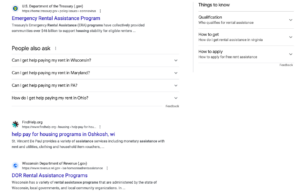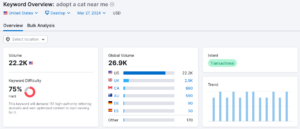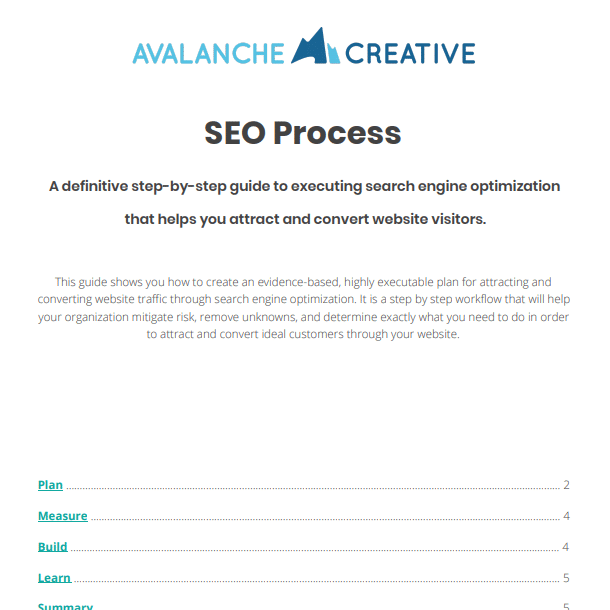An Expert’s Guide to SEO for Nonprofits
Category: Industry Guide, Search Engine Optimization | Tags: SEO, industry, search engine optimization
Using SEO for nonprofits can help your organization attract more donors, connect with members of your community who need your services, and build your brand. Use this guide to explore how you can approach using SEO strategies to get results for your nonprofit or charity.
An Example of How Nonprofit SEO Works
Put yourself in the shoes of the people you serve for a moment. Suppose someone in your community in Wisconsin was recently laid off from their job, and they know they’re not going to be able to pay the rent this month because they were already dealing with other financial issues. They know they need assistance, but aren’t sure where to start, so they turn to Google.
Here are the results for the term “rent assistance program,” which they might use to start getting the help they need:

There are informative, relevant results available from government organizations and nonprofit services describing some of the rent assistance programs available to them in their area.
After these listings comes the “People also ask” feature, which lists other questions that people ask Google relating to this query.
Consider the type of person that would be searching for these services. They likely know they need help to keep a roof over their head and are looking for ways to get help. Google understands that people are unique, so it wants to offer them well-written, unique solutions that will help them get what they need.
Explore how your nonprofit organization can use a data-based, empathy-driven SEO strategy to help these people find your services.
The Importance of SEO for Nonprofits
In short, SEO works. People trust search engines to find the answers and solutions to their problems, including the ones your nonprofit organization addresses. That includes people of all ages, genders, and racial demographics who are more likely to use your nonprofit’s services. However, most nonprofit organizations have trouble getting in front of the communities they serve through digital channels.
This is especially true for nonprofits that try to prioritize pay-per-click ads over other forms of digital marketing.
Studies have shown that organic search traffic is responsible for more than half of all website traffic, with paid search engine marketing accounting for roughly 15 percent. In fact, most people tend to scroll past the paid search ads at the top of the results when they’re looking for answers. In short, if you’re relying too heavily on pay-per-click advertising, you could be missing out on connecting with donors and members of your community.
How to Market Your Nonprofit
The key to successfully marketing your nonprofit organization is to focus on the communities you serve and address their concerns and questions first on your website. Before you even think about launching your first nonprofit SEO campaign, you need to know who you’re marketing your mission to. You need to know more and care more about the communities you serve.
Online content isn’t just a blog post anymore, nor is it an email newsletter you send out once a quarter to donors where your board of directors self-aggrandize for 500 words each. It’s images, video, slideshows, web applications, and more. All of this content can help establish your organization as a leader in your community and help you find both more funding and more people to serve.
Imagine being able to solve problems for the populations you serve or the donors you work with before you’ve even spoken to them. Great online content with a robust SEO strategy makes that possible. Engaging with those audiences first both creates opportunities for new donors and brand advocates for your organization.
The strategy, tactics, and marketing channels you choose, along with the time and capital investments you make, all need to hinge on your target audience. Find out information about the people you serve like:
- What is their day-to-day job like?
- What problems are they facing from day to day?
- What else do they search for?
- What are they going to experience before they need your solution?
By listening to members of your community and elevating your empathy for them, you’ll start to get a clearer picture of how they might use search engines to find your solution and the types of content that will bring them to your website. The same principle applies to attracting more donors, sponsors, and contributors.
Parts of a Good Nonprofit SEO Strategy
Local SEO
Local SEO comprises a set of strategies that help your nonprofit organization’s website and branding become more visible to people who are looking for your services in their area.
Local SEO tactics are essential, especially for nonprofits with localized chapters. For example, if your organization runs a community food pantry, using local SEO makes it easier for someone who needs food to find directions to your location and see if it’s right for their immediate needs when they’re experiencing temporary food insecurity.
Here are some of the most common methods for improving local search engine presence:
- Create and maintain a Google My Business account, both for your organization as a whole and as individual chapters.
- Mention your service areas on your website, including on specific location-based pages for every city or municipality you serve and the service lines you offer there.
- Make sure you are listed on local directories like your local Chamber of Commerce and resource networks for those in need.
On-Site SEO
On-page SEO refers to the keywords, page titles, headings, meta descriptions, and other information that Google uses to crawl and index your site. Making sure your on-page SEO is clear, readable, and relevant will be essential to helping the website rank for the keywords you’re targeting.
In turn, it’ll be that much easier for the groups you serve to find your nonprofit organization and connect with you.
Another way nonprofits can take extra steps with on-site SEO is by setting their site up for accessibility. This includes adding relevant alt text to your images and other visual elements for people who use screen readers, offering high-contrast options for those with limited vision, and making your site easy to navigate for people who can’t use a mouse or standard cursor.
Off-Site SEO
Off-site SEO refers to the tactics you use to optimize your nonprofit’s presence on platforms you don’t own. While off-site SEO isn’t as easy to control as what’s on your website, it’s incredibly valuable because it helps your organization build credibility with search engines, which in turn connects you with more people. Common tools and tactics for improving off-site SEO for charities include:
- Link building: Link building is the process of building relationships with other legitimate websites, including blogs and directories, so they will provide links back to your site to improve its credibility with search engines. The process can take time, but it can make a massive difference in how your pages rank on search engine results pages (SERPs), where the people you serve will see you among the top websites.
- Using social media: This includes both posting regularly and including links to your website in your organization’s social media profiles. Encouraging satisfied community members and your top brand advocates to review on social media sites or your company’s Google My Business listing can also support your off-site SEO tactics.
- Brand monitoring: Whether you use a brand monitoring tool or hire an agency to help you with the work, this can help you track what people are saying about your nonprofit and where on the internet there are links to your site.
Improving User Experience
A key part of digital marketing for nonprofit organizations is building a website that is clear, attractive, and easy to navigate. This is because good user experience can help you climb the ranks of Google’s search engine results pages. If a potential donor or volunteer finds your website to be slow and hard to navigate, they might give up before they can sign up to help you. This also isn’t helpful for people whole need your services but can’t easily find what they’re looking for.
Making It Easier to Connect When It Counts
Alongside improving your overall user experience, it’s essential to make it easier for the people who need your organization’s services the most to find you and connect with you.
In practice, this means:
- Keeping online forms short and sweet—they shouldn’t have to fill out 20 fields with their information just to schedule an appointment.
- Providing click-to-call links and other ways to convert.
- Having live chat available
Using Internal Links for Improved SEO
Internal links are worth their weight in gold. They’re a great way to smoothly funnel your readers to other helpful blog posts and eventually send an email, fill out a form, or make a phone call.
For example, if donors are landing on your site to answer general questions, they may leave if they read content that’s more interested in convincing them to donate than educating them about the work you do. Internal links allow your visitors to decide when they want to continue reading and when they want to reach out to your team.
Content Marketing for Nonprofits
How to Identify Content Marketing Ideas
Content should be the cornerstone of the digital marketing strategy for your nonprofit organization. In turn, it’s essential to talk to your audiences to learn more about them and conduct keyword research.
By using keyword research tools like SEMrush, you can build a list of great content marketing ideas for your nonprofit and attract more donors, recipients, and supporters. You can also get ideas of the types of content that could work well to attract these individuals, including video, infographics, and more. A good keyword research tool will provide the following:
- Related keywords
- Search volume
- Keyword difficulty
- Competitiveness
- And more
When you write and produce great content that’s relevant to the work your nonprofit does, you build domain authority with Google. By focusing on writing quality content on the questions, topics, and subtopics people search for relating to your services, you’ll start to bring in more traffic—and leads for larger donations.
How to Help Your Content Stand Out
The internet is bursting at the seams with websites that don’t provide direct answers to people’s questions. Therefore, offering direct, straightforward answers to your visitors’ questions allows your organization to cut through the noise. In turn, this also allows you to build credibility and makes your visitors more likely to return and convert.
Identifying Nonprofit Keywords
Finding the best SEO keywords for nonprofits takes research. It also requires you to look into the intent behind the phrases people use to find what they’re looking for. As an example, someone searching for the phrase, “food pantry near me,” will likely have a different set of needs and intentions than someone searching for the term, “volunteering at a food pantry near me.”
When you write dynamic, specific pieces of content that address the communities you serve and how others can help you serve them, you’re more likely to attract the audiences you’re looking for—on both ends of your services.
For example, if you’re marketing for a network of humane societies in your county, you may want to research the keywords potential pet parents are using to look for your services. You may find they’re using different terms than you would use to describe your services internally, instead looking for phrases like, “adopt a cat near me.”
Revisiting the above example, “adopt a cat near me” received over 20,000 searches within the United States at time of writing.

SEO Marketing for Nonprofits with Avalanche
When you work with the experts at Avalanche Creative, you can rely on our experience to get you great results with our SEO strategies for nonprofits. We know your marketing department already has a lot on their plates, and they’re probably not able to add anything else to their to-do list. That’s why we offer a broad range of SEO and digital marketing strategies for nonprofits that will make your job easier and allow you to reach more people.
Schedule a call with our staff to see how Avalanche Creative can create an effective SEO strategy for your organization.
Evidence-Based Digital Marketing for Nonprofits
At Avalanche Creative, we build evidence-based, highly executable search engine and content marketing plans for nonprofit organizations of all types. When you start working with us, we’ll spend the first two months of our partnership conducting extensive research into your website, your donors, and the populations you serve to create a custom plan that’s unique to your organization.
We’ll also spend time getting to know your organization’s services inside and out. This allows us to market them and write about them with accuracy and intentionality.
Other Nonprofit Marketing Resources
Since your potential donors and the communities you serve are most likely to look for your services when they have a problem they need to solve, it’s essential to build your brand awareness early in their journey. That way, they’ll be more likely to seek you out when they’re ready to connect with you. Outside of SEO and content writing, that can include:
- Paid search, also known as search engine marketing (SEM)
- Email marketing
- Your website
- Social media advertising
- Network marketing
Start Building Your SEO Strategy
Ready to improve your outreach and connect more effectively than ever with your community? Connect with our team today to get started.
Share this article:
The Avalanche Email: Fun. Simple. Educational. No Selling.
Learn Result-focused SEO & Content
Join over 2,272+ others who get one email every Wednesday with simple instructions on how to get more website traffic and leads through SEO and content marketing. (Learn more about the email)
Keep Learning
🏔️ Hook, Line, and Sinker 🎣
Use this fishing framework to turn your posts into stories that capture attention, create tension, and inspire action from your audience.
🏔️ Avoid Everything That Doesn’t Move You Forward
Stop chasing shiny tools and refocus on what moves your marketing toward the end zone. Simple steps to cut noise and make steady progress.
🏔️ Stop Tuning the Race Car That Won’t Win a Race
Site speed won’t fix a weak message. Focus on clarity, trust, and real value first. Here’s how to build a website that actually works.
🏔️ Earning Preference > Tracking Visibility
Hi friend, Lance here. Today’s email is about a shift we’re seeing and feeling across marketing teams right now: We’re obsessed with tracking visibility but under-invested in earning preference. 🚨 The Problem Every marketer I talk to wants to know how their brand shows up in AI search, LLMs, and assistants. We’re running to new tools that track…
What’s the Best CMS for Landscaping Businesses?
Compare the best website platforms for landscapers. Learn the pros and cons of Wix, Squarespace, and WordPress, and why WordPress is best for long-term SEO.




